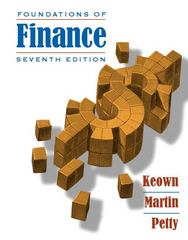Question
Jay Johnson Jay Johnson recently became a proud alma mater of an online university, a joint venture by several prestigious international universities set up in
Jay Johnson
Jay Johnson recently became a proud alma mater of an online university, a joint venture by several prestigious international universities set up in response to challenges from MOOCs. He graduated with a degree in finance and a 4.0 GPA by "collaborating" with better students in individual online-based assignments. Although he was interviewed by many bulge-bracket investment banks, he did not make it past the first round for any of the interviews since he does not really know much finance, including the basic tenet that "there is no free lunch". Interestingly, this tenet applies to life as well?choices that Jay made during his university days out of convenience have come back to haunt him. After some thirty interviews, Jay finally landed a corporate finance job with Alset.
Alset Private Limited
Alset, a private company incorporated in Singapore, manufactures parts for automobile manufacturers worldwide. The company was incorporated in 2000 and today produces a full range of products, including windshields, brakes, power seats, instrument panels, battery chillers, acoustic dampers, liftgate gas springs, and power steering mechanisms.
In the last month, Alset has received two new orders for the delivery of parts over three years:
The first order is for customised batteries for Specific Motors, a new customer that manufactures electric cars and has the potential of becoming a major customer in the future if electric cars take off in a big way. The contract has deliveries that match the expected demand for electric cars and, so, most of the sales is toward the end of the contract.
The second order comes from Toyoda Motors, Alset's largest customer. It requires new airbags urgently, which can be easily produced and provides a revenue bump in the first year, followed by seemingly stable revenues for the next two years. While Toyoda Motors has been a good customer in the past, its orders have decreased by 25% over the last two years because it has ordered parts from other suppliers who promise to deliver at competitive prices, sometimes at the expense of quality.
The expected revenue (in S$ millions) from the two orders are as follows:



Step by Step Solution
There are 3 Steps involved in it
Step: 1

Get Instant Access to Expert-Tailored Solutions
See step-by-step solutions with expert insights and AI powered tools for academic success
Step: 2

Step: 3

Ace Your Homework with AI
Get the answers you need in no time with our AI-driven, step-by-step assistance
Get Started


